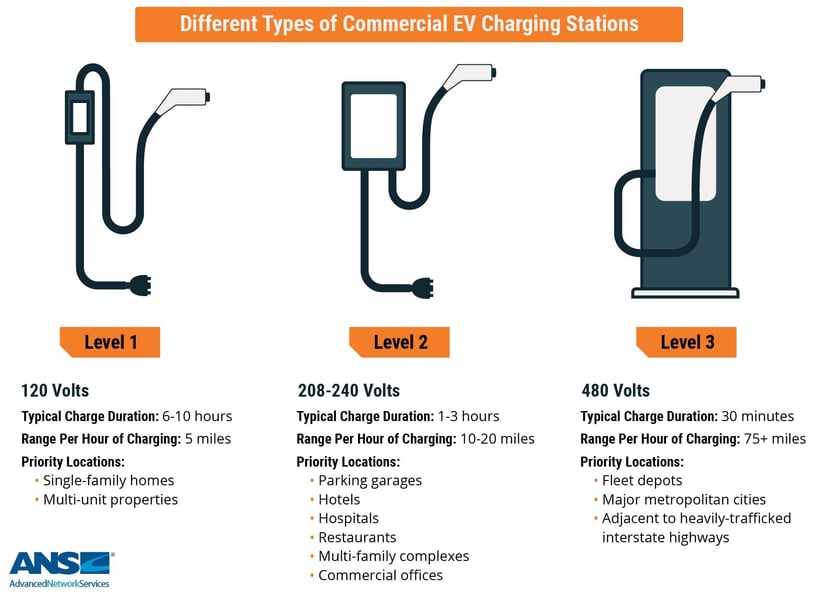It’s becoming increasingly essential for businesses across industries to install commercial electric vehicle (EV) charging stations to meet the growing needs of consumers and tenants. The forward-thinking companies choosing to install EV charging stations at their workplaces are reaping numerous benefits and positioning themselves as early adopters of the future of transportation.
Regardless of industry, EV charging solutions exist for every type of business. However, installing on-site EV chargers is a complicated process, and the challenge lies in knowing which solution is right for your organization.
To help flesh out your charging strategy, here are three key considerations when installing commercial EV charging stations at your location.
1. Business Goal Alignment
The first step to creating an effective EV charging strategy is to unpack the needs and wants of your business. Companies can use the following questions to assess their EV charging goals.
Who will be using the charging stations? - Businesses need a deep understanding of the behaviors and concerns of their target demographic. An EV driver at a shopping center will have different charging needs than EV fleet drivers. With clear use case visibility, businesses can match charging station type with the charging speed needs of their consumers.
How many EVs are expected to charge per day? - Understanding the number of vehicles projected to charge at your location will help determine the quantity and types of EV chargers required. Companies should aim to have enough charging stations to serve every driver without overspending on unnecessary chargers.
Is attracting new employees a high priority? - With a global talent and skill shortage, businesses must prioritize what their employees value. On-site EV chargers are an effective way to attract or retain eco-conscious employees. Businesses can offer EV charging as a complementary service to satisfy their employees.
How important is ROI? - For many businesses, ROI is not the main priority when installing commercial EV charging stations. These companies may be leveraging the opportunity to retain talent, entice customers, build loyalty, or solidify a positive reputation for environmental responsibility. If high ROI is the goal, businesses should leverage government incentives and consider implementing a payment strategy to raise additional revenue. EV site hosts can charge based on use per hour, per session, or per unit of electricity (typically kilowatt-hour).
2. Charger Type
Businesses need to understand the different types of EV chargers to determine the solution that best fits their end-users’ needs. EV chargers use AC or DC power, have varying charging levels, various smart charging capabilities, and can be connected to intelligent remote monitoring software.
EV chargers are typically categorized in terms of charging levels: Level 1, Level 2, and Level 3 (DC Fast Charger, or DCFC). In general, the higher the charging level, the faster a vehicle will charge. Here’s a comparison of the different types of charging levels.

Defaulting to the fastest charging level or the most advanced charging station may not necessarily be the best solution for your property. Several factors will dictate which type of charging station is needed, such as:
- Amount of available power at the site
- The speed at which vehicles need to be charged
- Type of vehicles needing to be charged
Keep in mind that some properties may benefit from a mix of Level 1, Level 2, and DCFC. The best charging strategy for your property will satisfy EV drivers in terms of convenience and accessibility.
3. Station Location
Once you’ve determined the charging option that best fits your environment and business goals, the next step is determining the ideal placement for charging stations. When determining station location, it’s important to consider the distance between the electrical panel and the physical charging station. A longer distance will increase the need for trenching and wiring, which in turn raises installation costs. Businesses should aim to minimize this distance as much as possible while still factoring in ideal placement areas such as:
- Building entrances
- High pedestrian activity areas
- Well-lit areas with clear signage
- Areas near the required power source
- Locations with a reliable Wi-Fi connection
Remember that a qualified EV charging provider can conduct in-depth site analysis and run through several options to determine which location best fits the criteria.
Implementing the Right Commercial EV Charging Strategy for Your Property
Before installing commercial EV charging stations, it’s imperative businesses consider several factors, including charger type, station location, and their long-term goals. When planned correctly, EV charging stations are a strategic way to generate additional revenue, retain talent, and entice customers.
Companies interested in installing commercial Electric Vehicle Supply Equipment (EVSE) should partner with experienced EV charging specialists. A qualified partner will provide complete solutions, including design, hardware, installation, software, and services to ensure uninterrupted hassle-free EV charging.






